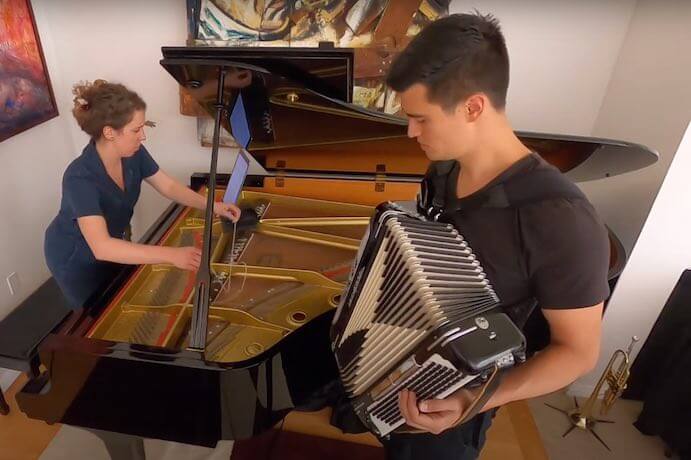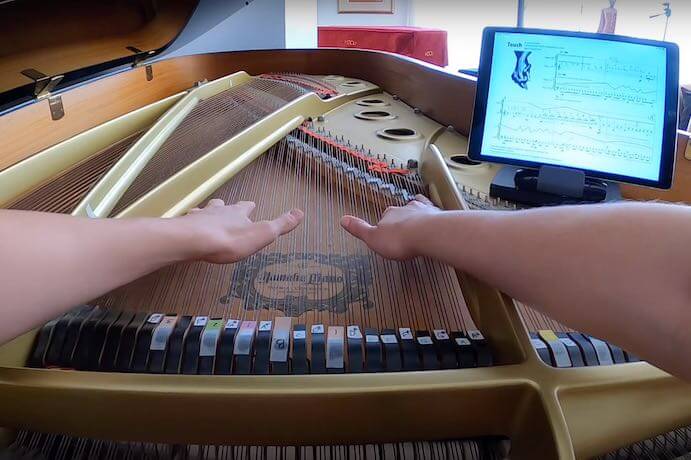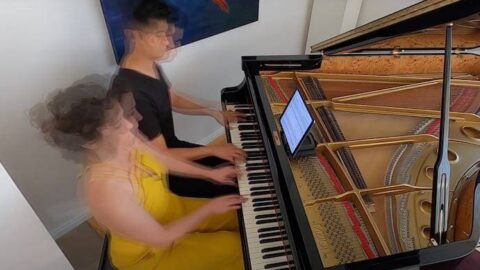In tandem with the evolving norms of the past year, Los Angeles based piano duo HOCKET (the combined hands of Sarah Gibson and Thomas Kotcheff) has taken to the internet in the presentation of a new series entitled #What2020SoundsLike.
With 2020 continuing to unravel in more and more harrowing ways, the integrity of the new music scene has remained stoic if not in flux. Sadly, as a result of the ongoing global pandemic, the delicate economy of live music (and the livelihood of its performers and content creators) has thus far taken a mortal blow. Nonetheless, adaptation rather than retreat has emerged as a rallying cry to keep the show going. While some have attempted to make new accommodations with a nostalgic “the way things used to be” kind of vibe, HOCKET’s #What2020SoundsLike remains acutely embedded in the present moment. Even the project’s name, stylized as a trendy hashtag, addresses the dominance of social media in its multifaceted role as potential savior and destroyer of worlds.
What HOCKET has done is commissioned fifty (50!) composers to create a miniature work that in some way expresses their unique perspective on the endlessly surprising events of the present. The result is a beautifully diverse and expressive panorama that, in summary, portrays something that is likely relatable to any listener about 2020; anxiety, frustration, fear, optimism, protest, resistance, retreat, isolation, and despite it all, finding ways to allow artists to come together and interact, even if we must be physically apart.

HOCKET performs these works seamlessly as an accomplished unit. The production quality of each video is spectacular, the details of which vary slightly to incorporate the character of each piece, when necessary.
Now complete, the project may be viewed on HOCKET’s YouTube channel. Works range from about 30 seconds to no more than two minutes, so the breadth of the project is consumable in around an hour, though many of these thoughtful works will inspire repeat viewing.
Here are some notable highlights:
feeling, scared today by Richard An; two melodicas mounted side-by-side emanate dissonant clusters, underscored by a delicate melody on the piano keyboard below. While the melodica is powered by breath, the brief piano part feels more like an apprehensive sigh, turned out like a question mark as if to say, “should I leave my house today?”
Ash Field by Annika Socolofsky; to anyone familiar with Socolofsky’s work, Kotcheff suddenly donning an accordion is no surprise. Gibson hovers over the piano and intones a two-note figure by drawing filament thread across two strings in the upper register. Most striking are the sounds and textures that fall between the notes, such as the clack of the accordion’s keys as the air is exhausted from the bellows and the buzz of the filament as it is pulled over the piano strings.

spiraling by Jane Shau-Lan Meenaghan; the use of one of those ring-for-service bells provides a center of gravity for otherwise cacophonous textures.
Les barricades quotidiennes by Christopher Stark; this work opens with a Chopin-esque etude that quickly fractures into a dream-like hallucination, phasing in and out of sync. This phasing effect is uniquely reflected in the video production, which mimicks the sonority visually until the piece resolved on a single note.
Touch by Nina C. Young; The crux of this work is the excitement of harmonic nodes on the strings by sliding a finger back and forth over a rhythmic ostinato on the corresponding key. A particularly appealing aspect of this video is the visibility of the beautifully engraved score mounted on the frame of the piano.

c** y** h*** m*? by Peter Shin; one conga, one antique cymbal and a simple arrangement of preparations to the piano provide a mid-playlist palette cleanser. The work’s title, with its blocked out letters, conjures familiar feelings of isolation and the reluctance to reach out experienced by many in quarantine.
Please Scream Inside Your Heart by A.J. McCaffrey; the infamous request made by a Japanese amusement park for patrons to keep their mouths shut while riding the rollercoaster (to prevent the spread of Covid) has become the stuff of meme legend. With a refreshing assortment of piano preparations, electronics, and percussion instruments, the title is perhaps the most relatable detail, since that is likely what we are all doing these days.
Kit01 by Hitomi Oba; the duration and execution of this piece is determined by the movement of a cluster of curlycue paper strips sliding along a string. The paper and stark abruptness of the material feels almost mystical and invokes images of Shinto cleansing rituals or a haiku-like observation of the present moment.

Yea, We Talked About It by Derrick Spiva Jr.; another work inviting the melodica into the mix. As the title may indicate, the material vacillates between quasi-unison and exciting periods of uplifting harmonies, and subtle conversational counterpoint. It never feels like an argument per se, maybe they worked it out?
Nobody Can Do It Like Me! by José Martinez; booming chords and clusters accompany vocalizations by each performer on phrases of reflexive praise. Each announcement is mildly anxiety inducing, rather like an argument unfolding in the comments section of a YouTube video.
I CARE IF YOU LISTEN is a program of the American Composers Forum, funded with generous donor and institutional support. A gift to ACF helps support the work of ICIYL. Editorial decisions are made at the sole discretion of the editor-in-chief. For more on ACF, visit the “At ACF” section or composersforum.org.
























